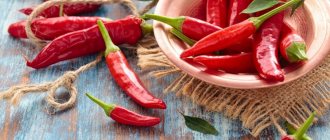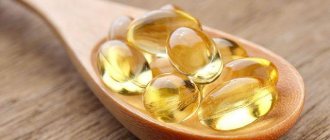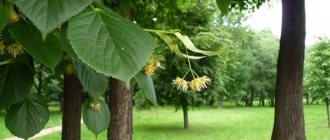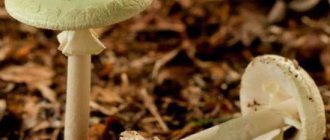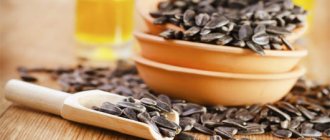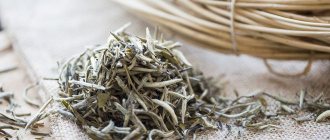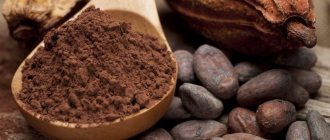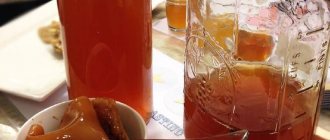Besides the Chinese, Indians and Sri Lankans, there are other peoples who are famous for their legendary teas. The pink inflorescence was considered an aristocratic plant. This is evidenced by the practice of taking a bath with rose petals. Flower drinks were popular among women.
Pink petals vary in color. There are scarlet, yellow, pink, red and dark colors. The combination of honey and rose tea helps to get rid of inflammation in the oral cavity.
Description of hibiscus tea
Hibiscus is the name of a drink made from African flowers. Originates in Africa. It is also called “ruby tea”. It was widespread in its homeland due to its usefulness. Pharaohs also added rose flowers to tea. People knew which rose was for tea. The Sudanese rose grows in Africa.
The plant is used to infuse a healthy drink. Sudanese flower is rich in citric and ascorbic acid. Rich in polysaccharides, anthocyanins, flavonoids. Hibiscus tea is the pride of the people of the Middle East.
It has many names: hibiscus (possibly spelled hibiscus), Sudanese rose and the drink of the pharaohs, Mallow of Venice, red tea, buzo and many others. It is a traditional tea drink of Egypt.
It is produced from the petals of a tropical plant - hibiscus or rosella (Malvaceae family) - in many hot countries:
- in Egypt;
- Sudan;
- China;
- India;
- Sri Lanka.
Herbal infusions
Herbal tea for gastritis plays an important role, thanks to the combination of different herbs, you can lower or increase the level of acidity.
What tea to drink for gastritis with high acidity? To prepare a tea drink, take in equal proportions:
- Mint leaves.
- Linden flowers.
- Fennel fruits.
- Flaxseeds.
Pour in warm water, then wait until it boils. Cool the drink to room temperature; you can even drink it chilled.
This herbal drink will coat the gastric walls and reduce the level of secretory activity of cells.
In this case, chamomile tea will also be useful; brew chamomile (purchased at a pharmacy); you can add a mint leaf to improve the taste.
You should know: if you drink chamomile tea frequently, you may develop dysbiosis, so you should not take it more than twice a week.
How to drink hibiscus tea
This tea is tropical. In addition to the benefits, there is a need for a refreshing effect. Surprisingly, hot teas help relieve heat just as well as cold ones. Therefore, it is prepared in several ways.
Hot method of brewing hibiscus tea
- For one teaspoon of tea leaves you need to use two hundred to two hundred and fifty milliliters of water. It should be soft, low mineralized or at least filtered, but in no case tap water.
- Heat the water to ninety degrees.
- Pour heated water over the tea leaves and let it steep for three to five minutes.
- Boiling water, as well as steeping for too long, negatively affect the taste, aroma and color of the drink.
The second way to brew hibiscus tea is cold
- Pour a few spoons of Sudanese rose petals into one or two liters of water.
- The requirements for it are the same. Let it brew for several hours.
A refreshing way to brew hibiscus tea
- Pour a few teaspoons of tea leaves with cold water.
- Let it brew for two hours.
- After boiling, cool, add ice.
The result is a wonderful refreshing drink - just right on a hot summer day. You can add dried fruits, dried apricots, nuts, and honey to tea. Some people add regular white sugar to it. But it's better not to do that. The finished drink has a noble sweet and sour taste, similar to the taste of fruit drink.
In another article, we described green tea with milk for weight loss.
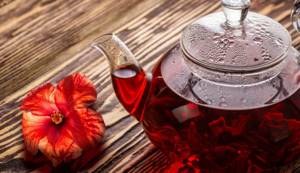
Methods of brewing tea
There are several ways to brew hibiscus. You can do this:
- in a jug
- cup or teapot,
- cold or hot water.
Cooking Chinese rose is also possible.
If you adhere to traditions and rules, then you need to brew the drink exclusively in clay or glass containers; porcelain and ceramics are suitable.
It is unacceptable to do this in metal or plastic containers. Such materials worsen the color, aroma, taste of tea and destroy the beneficial properties.
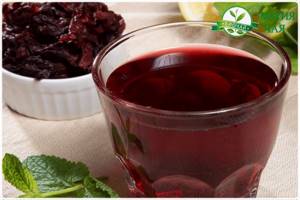
Hot brewing
To prepare a hot drink, you will need 1-1.5 teaspoons of dried hibiscus flowers and 250 ml of boiling water.
- The raw materials should be filled with hot water,
- cover the teapot with a lid,
- leave to infuse for 10 minutes.
Those who want stronger tea can wait longer.
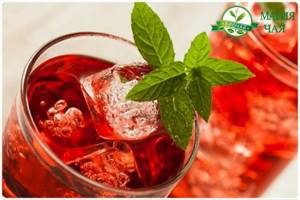
Cold brew
In this case, 1.5 teaspoons of raw material are poured into 250 ml of cold filtered water and left for 3-4 hours. They say that in this case, all the beneficial substances contained in the hibiscus remain in full.
Cooking
During cooking, the drink loses some healing properties, but the taste is special, which impresses many gourmets. The proportions are unchanged - 1.5 tsp. hibiscus per 250 ml of water.
- Combine the ingredients and place on low heat.
- Bring to a boil and cook for 3-5 minutes.
- Can be consumed both hot and cold.
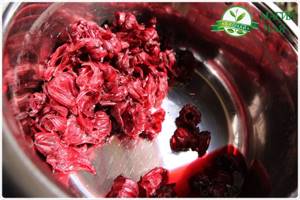
Hibiscus tea beneficial properties
In the Arab homeland, hibiscus tea is considered a remedy for all diseases. This is justified. Its benefits are determined by its chemical composition:
- Anthocyanins - substances that give it a ruby color - contain vitamins of group P. Their benefit is to strengthen the walls of blood vessels and regulate their permeability.
- Antioxidants. We can talk about their benefits for a very long time, so we won’t go into details.
- Lots of vitamins.
- Useful microelements: calcium, phosphorus, magnesium, etc.
- Organic acids (including citric acid).
Rosella tea has a diuretic, antipyretic, and laxative effect on the body. It is very good for fever or colds: hot tea “accelerates” leukocytes that fight viruses.
By stimulating urination, it removes toxins, waste, excess salts, unnecessary fluids from the body, and promotes weight loss. It can be used as a laxative during constipation.
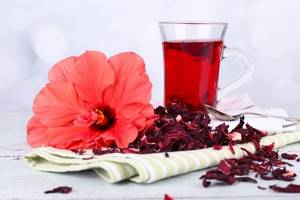
Is it possible to have tea for pancreatitis?
Tea can be drunk by anyone whose manifestations of pancreatitis have already become chronic. If you have pancreatitis, you can drink not only black, green tea, oolong or pu-erh. Hibiscus and fruit drinks are allowed to a limited extent. Rosehip is a priority.
Black
Pectins, which are contained in tea leaves that have undergone long-term fermentation, have a beneficial effect on digestion and prevent indigestion. But you should not drink it brewed strongly, as this can lead to pancreas spasm.
Green
More useful than black. It contains tannin, which can support vitality, tones the immune system and promotes the absorption of ascorbic acid. Therefore, it is better for those suffering from pancreatitis to give preference to this variety.
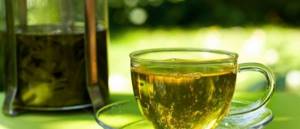
White
People with pancreatic problems can choose white tea for pancreatitis. This variety is superior in its beneficial properties to black and green and has a positive effect on the body. When producing this tea, only the top leaves of the tea bush and young buds are collected. It undergoes minimal processing, so almost all the beneficial substances remain in it. Its only drawback is its high price.
Yellow
For pancreatitis, it has an antispasmodic effect. It also helps the body fight infections, headaches, invigorates, and clears the mind. For many years, Chinese emperors enjoyed the privilege of drinking this tea, and the method of its production was kept strictly secret. Yellow tea contains amino acids, polyphenols, vitamins, and microelements.
Red (oolong)
For pancreatitis, this drink soothes the irritated pancreas. Additionally strengthens blood vessels and prevents the development of thrombophlebitis. Experts classify Oolong as something between black and green tea. It has the bright aroma of green tea, but has the rich taste of black tea. Oolong is rich in vitamins, microelements, and has a high polyphenol content. It contains manganese, which promotes better absorption of vitamin C by the body.
Pu'er
Pu-erh occupies an important place among the varieties of pancreatic tea. It fights digestive system disorders better than all other varieties and improves metabolism in the body. Gastroenterologists recommend consuming pu-erh for people with peptic ulcers, as it gently reduces stomach acidity and promotes better absorption of food.
Each of these varieties is allowed to drink up to 5 glasses per day during remission.
This is not the entire list of varieties. It is best to discuss what tea you can drink for pancreatitis with your doctor.
Other examples
If the doctor has forbidden you to drink tea for pancreatitis, the drink can be replaced with others. The use of hibiscus, rose hips, and fruit teas significantly reduces the manifestation of chronic pancreatitis.
- Hibiscus is a red drink made from the dried leaves of the Sudanese rose (hibiscus). You can drink this tea, but with caution due to the property of hibiscus to increase the acidity of the stomach, which is undesirable during periods of exacerbation of pancreatitis. It contains a large amount of antioxidants, so consuming hibiscus a few days after an attack of pancreatitis will help replenish the salts and trace elements lost during stool disorder. 1-2 cups per day are allowed.
- Rosehip decoction, like hibiscus, has a sour taste. It is allowed to be used during an exacerbation of pancreatitis, but only weakly. This drink contains a large amount of ascorbic acid, which can irritate the gastric mucosa, and also has a choleretic effect. A few days after an attack of pancreatitis, rose hips will help relieve spasm and inflammation, normalize metabolism, and promote organ regeneration. Rose hips are drunk 50 g 3-4 times a day.
- Fruit tea is a drink made from fruits and berries by brewing them with boiling water. It can be prepared from fresh, dried and frozen products. It is worth distinguishing it from tea with fruit flavors. Flavorings, as a rule, are not natural, and instead of the expected benefits, they can cause allergies. Homemade fruit drink is fortified and has a pleasant taste. But doctors do not recommend drinking this tea for pancreatitis immediately after an exacerbation, since it increases acidity and irritates the inflamed pancreatic mucosa. Patients with chronic pancreatitis are allowed to drink one or two glasses of fruit drink a day, but not during an exacerbation and not on an empty stomach.
For pancreatitis, it is recommended to prepare jelly and jellies from fruits, which are better absorbed and have a gentler effect on the mucous membrane of the digestive organs.
Rose tea: benefits and harms
- This drink is recommended for colds.
- The drink helps resist neuroses and fight pulmonary diseases.
- In China, locally sourced rose is used. The pink drink is widespread due to its fortified composition. Vitamins K, C, E, D, PP predominate in the composition. Citric and malic acid are present.
- Contains resins, tannins, glucosides and calcium, essential oils, and other necessary substances.
- This drink is beneficial for men and women and helps cleanse the blood, getting rid of toxins and waste.
- Rose petal tea has an anti-inflammatory function.
- Also reduces the risk of blood clots.
- Has a healing effect on the digestive organs.
- The inflorescence is also used in the production of medicines.
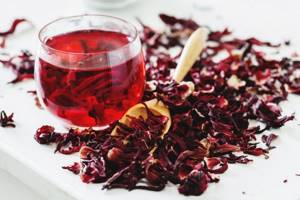
If you haven’t tried it, then try the effect of the medicinal drink for yourself. It will energize, relax, and increase appetite. Preferable for people with stressful professions.
It is suitable for people with weakened immune systems, type 2 diabetes, and people who suffer from hypertension (high blood pressure).
If you are healthy, then you should not neglect this “super tea”. Regular consumption of hibiscus will prevent many diseases. A cup of aromatic hibiscus in the morning will charge you with energy for the whole day, “sober up” your mind, and help you “make this day.” Hibiscus has many beneficial properties. It was not for nothing that it was one of the most beloved folk remedies among Arab healers.
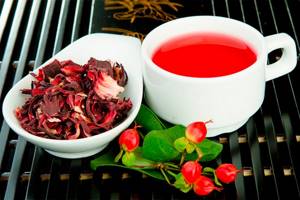
Medicinal properties
If you regularly drink hibiscus, your teeth, hair and bones, the walls of blood vessels will become stronger, and cholesterol in the blood will decrease.
- Can be used as an anthelmintic and for allergies.
- Sudanese rose will help prevent anemia, vitamin deficiency, and improve mood and immunity.
- It is recommended for use by people with unstable mental health, those suffering from insomnia, and chronic fatigue.
- Hibiscus also serves as a cancer prevention, slows down the growth of tumors, and helps treat oncology at an early stage.
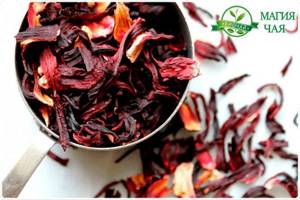
For men
The healing properties for men include improving blood circulation and strengthening blood vessels. The diuretic effect prevents inflammatory diseases of the urinary organs. All this eliminates premature problems with potency.
For women
Hibiscus will also be a salvation if you have irregular, painful and heavy menstruation. The drink normalizes the menstrual cycle, somewhat “pacifies” bleeding and has an analgesic effect.
Can influence the restoration of hormone balance, reduce symptoms associated with menopause, minimize depression, irritability and anxiety.
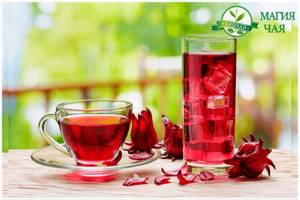
What does hibiscus look like?
The plant is grown in tropical climates. It grows in the form of a bush and belongs to the mallow family.
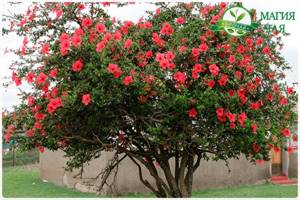
Hibiscus is very similar to the common “Chinese rose”, which is planted as a houseplant. The flowers of this culture are large – they can reach up to 10 cm in diameter.
The unusual aroma from the bright red flower emanates even at a great distance. We’ll talk about the benefits and harms of hibiscus later.
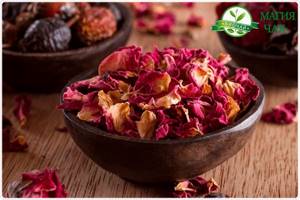
Most preferred types of tea
Monastic tea for gastritis
Monastery tea for gastritis has become widespread ; such confidence in this product is due to the following factors:
- Healing composition of tea: Flaxseed has an enveloping effect on the irritated stomach, thereby eliminating inflammation, relieving pain and soothing it.
- Calendula, which is part of the composition, is an excellent prophylactic for various disorders of the gastrointestinal tract.
- Thanks to wormwood, parasites are destroyed in the stomach and the digestive system is improved.
- Horsetail treats stomach disorders.
You can learn more about this tea from the article by Elena Malysheva.
Hibiscus tea.
Hibiscus, which came from ancient India, has won everyone's trust thanks to its red flowers, from which an amazing oriental drink is produced - hibiscus tea. It is characterized by a burgundy hue, a spicy aroma and a unique, slightly sour taste.
It is widely considered a medicinal herbal plant, and its dried fruits include components such as
- Magnesium.
- Iron.
- Potassium.
- Phosphorus.
- Pectin.
- Vitamins A and P, as well as group B.
- Querticin.
- Bioflavonoid.
- Amino acids
- Beta carotene.
In addition, one serving of tea includes a combination of proteins, fats and carbohydrates, which are the key to the proper functioning of the body's metabolic system.
Thanks to such an amazing composition, which includes all the beneficial substances, hibiscus is often drunk for diseases such as gastritis, even during exacerbations .
Anthocyanins contained in the flowers of the plant improve the condition of blood vessels, increase the level of immunity and become a protection against viruses and infections. Tea perfectly regulates cholesterol levels.
Hibiscus has an antiseptic effect, it relieves inflammation and pain, and heals irritated gastric walls.
This type of tea will be a real salvation for gastritis and stomach ulcers.

